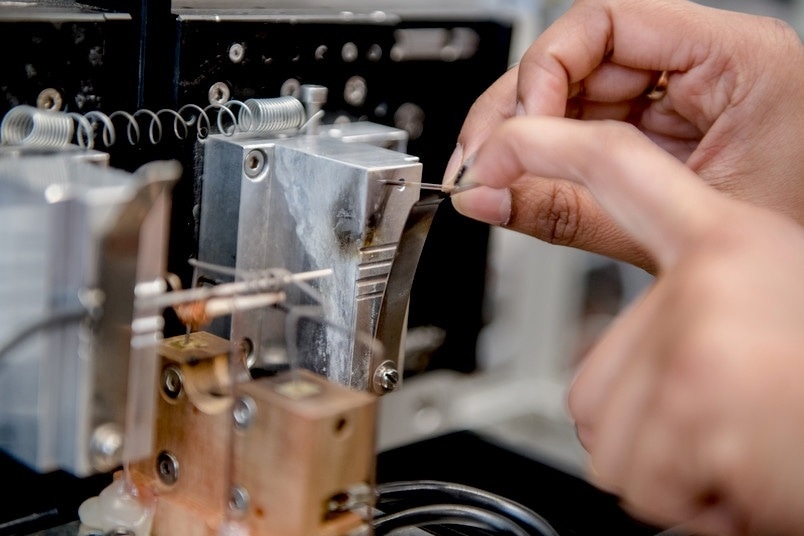May 6 2019
It is hard to study single nanoparticles as they are very small. However, this is what exactly scientists are looking for to customize their properties. And they have come up with a new methodology—particle at the stick.
 Invisible to the naked eye: at the tip of this carbon nanoelectrode, the tiny catalyst particle is located. (Image credit: © RUB, Marquard)
Invisible to the naked eye: at the tip of this carbon nanoelectrode, the tiny catalyst particle is located. (Image credit: © RUB, Marquard)
There are several means to use nanoparticles as catalysts. In order to customize them in a way that they can boost certain reactions efficiently and selectively, scientists must determine the properties of single particles as accurately as possible. To date, a collection of several nanoparticles has been studied. However, the challenge of these analyses is that the contributions of various particles interfere such that the properties of individual particles remain hidden.
Scientists at Ruhr-Universiät Bochum together with colleagues from the University of Duisburg-Essen and Technical University of Munich have created a new technique to examine single nanoparticles before, during, and after an electrochemical reaction. They describe the process in the journal Angewandte Chemie, reported on April 16th, 2019.
Observing the Complete Lifecycle
To comprehensively understand the catalytic activity of a nanoparticle, we have to observe how its structure and composition change—from the pre-catalyst to the active catalyst and eventually all the way to the condition after the reaction. This is why we have developed the particle at the stick.
Professor Wolfgang Schuhmann, Head, Center for Electrochemical Sciences, Ruhr-Universiät Bochum
The scientists cultured a catalyst nanoparticle at the tip of a carbon nanoelectrode, and then activated it and used it to catalyze an electrochemical reaction. In contrast to earlier methods, the new technique enabled the team to look at the entire lifecycle of the particle.
Fabricating the Particle at the Stick
In the first stage, the chemists tailored the carbon nanoelectrode such that the particle preferably adheres to the tip of the electrode. Then, they immersed the electrode’s tip into a solution, which included the precursor materials for the catalyst. Later, these components assembled automatically, eventually forming a symmetric particle in which the constituting components—the metal cobalt and also the organic carbonaceous elements—were uniformly distributed.
The team studied the shape of the particles with the help of transmission electron microscopy. Using a particular type of X-ray spectroscopy, the scientists determined the elemental distribution within the particle. They conducted these analyses again following each step in order to examine how the particle modified.
Stable Nanoassembly of Electrode and Particle
In the next step, the scientists used heating to activate the decomposition of the organic compounds and the development of a carbon matrix with extremely small embedded cobalt nanoparticles. In this way, the actual catalytically active material was developed at the tip of the nanoelectrode.
Later, the chemists employed the particle as a catalyst for the production of oxygen from water through electrolysis. The nanoparticle worked superbly and achieved turnover rates that are analogous to industrial electrolysis devices.
“For us it was yet even more important to see that the nanoassembly of electrode and particle was stable enough for a follow-up examination after catalysis,” states Wolfgang Schuhmann. The analysis showed that the particles were subjected to significant restructuring during the reaction. That way, the technique enables the changes of a catalyst to be observed at extremely high turnover rates.
In addition to determining the catalytic activity of an individual nanoparticle, the scientists used their approach to also monitor its shape and chemical composition throughout the whole lifecycle—completely without the interference of any other particles.
Funding
The research was funded by the German Research Foundation in the Framework of the Collaborative Research Centre 247 as well as the Cluster of Excellence RESOLV (EXC 2033).